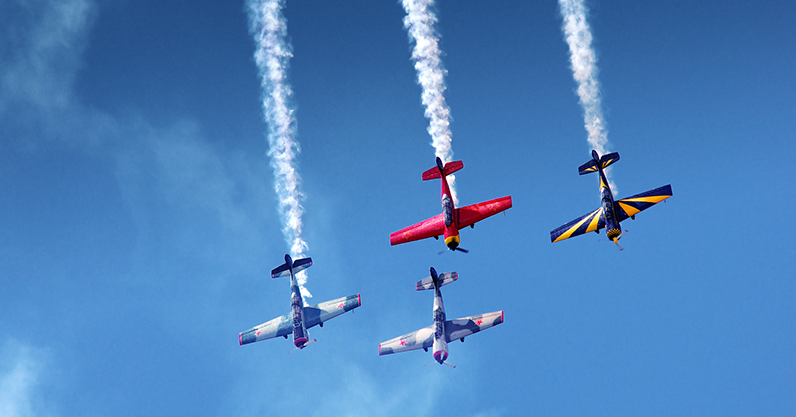By: Steven Daun, National Chief Pilot
You are 5 years old and sitting in the bleachers at an airshow with your friends or parents. As you look up into the sky, you see the shiny slick airplanes doing amazing tricks in the sky. It doesn’t take long before your mind puts you in the cockpit, and before you know it, you are flying the very airplane that you are watching.
Fast forward to your adulthood. You find yourself sitting in the stands thinking about many of the same things you thought about when you were 5 years old. How is this possible? I heard an old-time pilot once call it “aviation childhood airshow syndrome.” All it takes to become infected with this syndrome is an upside-down airplane and a loud engine. While there is no known cure for this syndrome, there are ways to treat it. The number one way is to go to an airshow or air race.
This year we took our mechanics to the Reno Air Races. As we were driving from our hotel to the Reno Stead Airport, you could feel the excitement starting to build. What were we going to see this year? How fast were they going to fly this year? The questions just kept popping into my mind. This feeling started the day before the air race when we looked into the sky only to watch a U-2 spy plane flying over.
As we parked our car, thousands of others made the same pilgrimage as we did. All were walking at a fast pace, excitement all over their faces, trying to get to the airplanes as quickly as possible. The bleachers limit your view from the parking lot. But you can hear the sound of airplanes flying low and fast. Walking a little faster, now you finally see it. Then shiny WWII vintage fighters dropping into the racecourse at the same time.
Unless you have ever experienced Reno, there is nothing else like it in the world. Walking around the pits, you can see the mechanics working on their aircraft to prepare them for their next race. Make no mistake. Unlike an airshow where you look at parked aircraft on static displays polished up to a high sheen. These are racing airplanes. Oil, grease, dust, and gas are everywhere. Airplanes are coated with oil and smoke residue.
The Lancair’s drop into the course for their race. Watching them race at speeds of 400 knots less than 100 feet above the ground is surreal. After two or three laps, the thought pops into your head. I wonder what it’s like to fly that airplane in this race. The pilot is pulling back hard, turning hard to keep a 90° bank. His leg is probably getting tired from having to push in all that rudder.
Next, come the Thunderbirds and a race back towards one’s own childhood. Everyone’s heads were looking up at the sky with that wondrous look on their faces. A jet passes from behind the bleachers to the show center with a full afterburner, and you couldn’t help but smile in delight. Five F16’s flying in every different direction, some right side up, others upside down, and some on knife-edge flight. How does it get any better?
Just when you think it can’t get any better, here comes ten P51’s dropping into the racecourse. That engine sound is distinctive. They are approaching 450 knots at less than 100 feet above the ground. The slower airplanes start to get lapped. The two airplanes out front are fighting each other for first place. You can hear the engines rev up higher; some smoke starts to appear as they are running as fast as they can. The checkered flag comes out, and the airplanes climb for the heavens to shed their excessive speed and cool down their taxed engines.
Walking towards the car to leave, there are remnants of the races in everyone’s mind. People are hand flying showing their friends their favorite parts of the races. And all that you can do is remember and look forward to next year.
You, too, can learn how to fly. You may not become an airplane racer, but you can certainly join the ranks of pilots who fly for themselves. Whether you are flying a P51 or a Cessna 172, the thrill of piloting your own airplane is the same. What are you waiting for?










